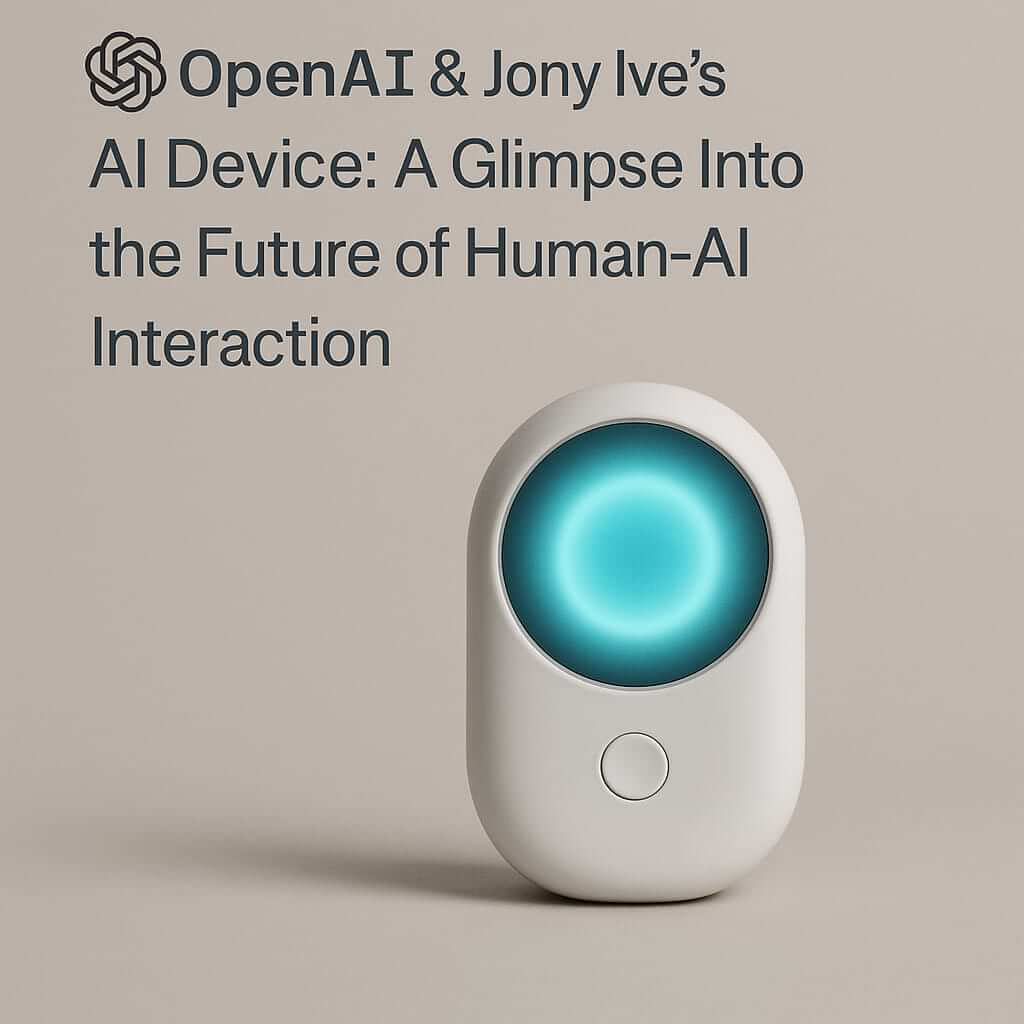In a world increasingly shaped by artificial intelligence, the collaboration between OpenAI and legendary product designer Jony Ive marks a pivotal moment in the evolution of consumer technology. This dynamic partnership aims to redefine how we interact with AI—moving beyond screens and keyboards to more intuitive, human-centered experiences.
The Vision: Redefining the AI Interface
OpenAI, best known for pioneering generative AI systems like ChatGPT, has joined forces with Jony Ive—Apple’s former Chief Design Officer and the creative mind behind the iPhone, iMac, and Apple Watch. Backed by over $1 billion in funding, including support from SoftBank and its CEO Masayoshi Son, this partnership aims to create an AI-first hardware device that could reshape everyday computing.
What’s the Goal?
The objective is to design a new category of AI hardware—a personal device that intuitively integrates artificial intelligence into users’ daily lives. Rather than mimicking smartphones or tablets, the device is said to focus on natural interaction, combining AI’s contextual awareness with Ive’s design finesse to achieve something truly novel.
What Do We Know About the Device?
While details remain closely guarded, a few important aspects have emerged:
- AI-First Design: The device will be built from the ground up with AI at its core—not as a feature, but as the foundation. This approach is aimed at overcoming the constraints of current smart devices, which are mostly app-centric.
- No Traditional Screen: Like Humane’s AI Pin or the Rabbit R1, this device may not include a conventional screen. Instead, it could rely on voice interaction, projection, or ambient computing principles to deliver information.
- Contextual Intelligence: OpenAI’s advanced models, such as GPT-4 and beyond, will allow the device to understand complex user contexts, learn from behavior, and offer assistance proactively.
- Minimalist Design: Given Ive’s design legacy, the device is expected to be elegant, minimalist, and crafted with high-quality materials. Expect a balance of aesthetic appeal and functional innovation.
Why This Collaboration Matters
1. The Future of AI-Integrated Hardware
For years, AI has been confined to software. This partnership signals a shift toward dedicated AI hardware, purpose-built to unlock new interaction paradigms. Just as the iPhone revolutionized the smartphone era, this device aims to usher in the post-smartphone AI era.
2. Human-Centered Design
Jony Ive’s involvement brings design credibility to AI, a field that often prioritizes engineering over user experience. Ive’s philosophy—where form follows function—could ensure the device is intuitive, accessible, and emotionally resonant.
3. The OpenAI Ecosystem
OpenAI’s ecosystem is rapidly expanding, from ChatGPT and DALL·E to API integrations with enterprise software. A dedicated device could create a new hardware-software symbiosis, where AI assistants are no longer locked behind screens but become embedded in our surroundings.
How Will It Compete?
With the rise of other AI-first devices like:
- Humane AI Pin
- Rabbit R1
- Meta’s smart glasses (Ray-Ban Meta)
- Samsung’s Galaxy Ring
…this new entrant faces competition but also tremendous opportunity.
Unlike these products, OpenAI’s device has the potential advantage of:
- Native integration with GPT models
- Visionary hardware design by Jony Ive
- A massive funding pool, suggesting scalability and polish from day one
Challenges Ahead
As promising as the project sounds, a few critical questions remain:
- Privacy Concerns: Always-on AI devices must tread carefully with user data. How will OpenAI and Ive ensure ethical AI use and data protection?
- Interface Adoption: If the device avoids screens, will users be ready for a screenless future? The learning curve might be steep for some.
- Cost: With such a premium team and design vision, will the device be affordable for the mass market or remain a niche luxury product?

What Could the Device Look Like?
Speculation ranges from a wearable to a home-based AI terminal, or even a portable ambient assistant. Some insiders suggest it could resemble a smart pendant or badge, worn on the body, listening and responding contextually—similar in spirit to Star Trek’s communicator or Tony Stark’s AI assistant.
Whatever the form, the essence is clear: a new computing experience untethered from traditional screens.
Conclusion: Toward a More Natural Relationship With AI
The OpenAI–Jony Ive collaboration has the potential to be one of the most transformative tech developments in the next decade. If successful, it could fundamentally shift how we perceive and use technology, moving us from passive users to active collaborators with AI.
As we await further details, one thing is certain: this partnership is not about creating another gadget—it’s about pioneering a new interface for intelligence.
Frequently Asked Questions (FAQ)
1. What is the OpenAI and Jony Ive AI device?
The device is a next-generation AI-first gadget being developed through a collaboration between OpenAI, renowned designer Jony Ive, and SoftBank. It aims to offer a more natural, human-centered way to interact with artificial intelligence—possibly replacing the need for traditional screens.
2. Will the device replace smartphones?
While it’s too early to say for sure, the project’s ambition is to redefine the future of computing. Rather than directly replacing smartphones, the device may complement or evolve past them, offering a smarter, more ambient AI experience.
3. What kind of AI will power the device?
The device is expected to be powered by OpenAI’s most advanced language models (such as GPT-4 or its successors), enabling it to understand natural language, provide contextual assistance, and possibly even use multimodal inputs like voice, gestures, or visuals.
4. Will it have a screen?
Based on reports, the device might not feature a traditional screen, distinguishing it from phones and tablets. Instead, it may rely on voice interaction, gesture control, or projection-based displays, emphasizing a hands-free, screen-free experience.
5. What is Jony Ive’s role in this project?
Jony Ive is leading the industrial design and user experience for the device. Known for his work on iconic Apple products, Ive brings a focus on simplicity, elegance, and human-centered design—ensuring the device is as intuitive and beautiful as it is intelligent.

6. When will the OpenAI AI device be released?
There is no official release date yet. However, with over $1 billion in funding secured and design work underway, many speculate that a prototype or announcement could arrive in 2025, with potential consumer availability in late 2025 or early 2026.
7. How much will the device cost?
No official pricing has been revealed. Given the premium design and cutting-edge AI, it’s likely to launch as a high-end device. Analysts expect it to be priced between $500 and $1,000, though this may change based on features and target market.
8. What will the device look like?
While the final design hasn’t been revealed, rumors suggest it may be a wearable or pocketable AI assistant, possibly resembling a badge, pendant, or clip-on device. Think minimal, futuristic, and functional—hallmarks of Ive’s design ethos.
9. How will it compare to the Humane AI Pin or Rabbit R1?
All three devices aim to make AI more personal and ambient. However, OpenAI’s device may offer a deeper integration with GPT models, more refined design, and possibly greater contextual awareness, setting it apart from competitors.
10. Will the device have internet connectivity?
Yes, it is expected to have constant internet access—likely via Wi-Fi and optional cellular connectivity—to leverage cloud-based AI processing and real-time updates from OpenAI’s servers.
11. Will it support third-party apps or services?
That remains unknown. OpenAI may opt for a closed ecosystem initially, similar to early versions of the iPhone, with later expansion to developer APIs and third-party integrations depending on demand.
12. Will it respect user privacy?
Privacy is a major concern for AI-first devices. OpenAI has stated its commitment to ethical AI and user data protection. We expect the device to offer transparent data usage controls, offline modes, and robust encryption to gain user trust.
13. What kind of tasks will it help with?
The device may support a wide range of tasks, including:
- Voice-based reminders and scheduling
- Real-time translation
- Context-aware recommendations
- Home automation
- Personal knowledge retrieval
- Creative brainstorming and writing
- Health and wellness insights

14. Will it support multiple languages?
Given OpenAI’s multilingual capabilities in GPT-4, the device is expected to support global languages from launch or shortly after—ideal for international users and multilingual households.
15. Where will it be available?
Initial availability may be limited to the U.S. and select international markets, with broader global rollout following successful reception and scaling. Availability in regions like Europe, India, and East Asia will likely follow.
Explore more visionary innovations in the Future Tech & Emerging Trends section on NewTech—where tomorrow’s technology comes to life.






No responses yet